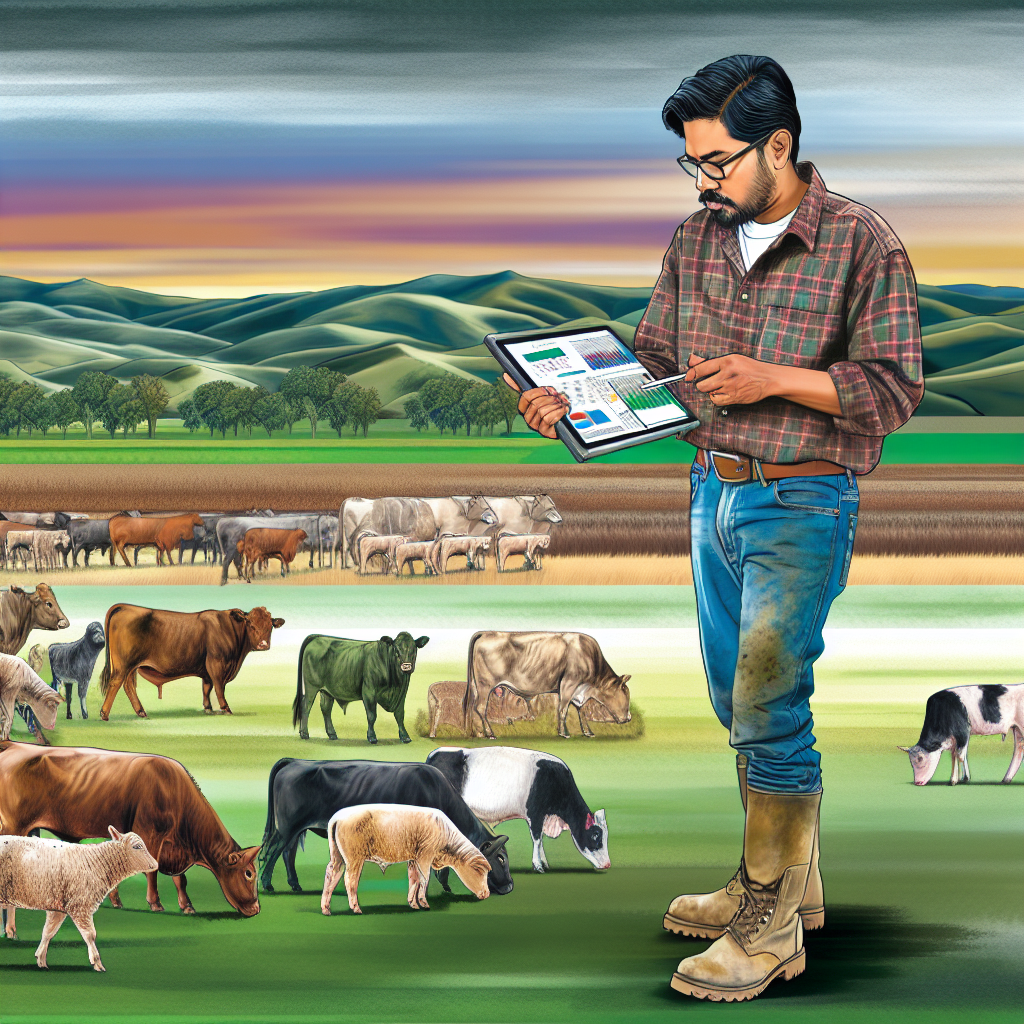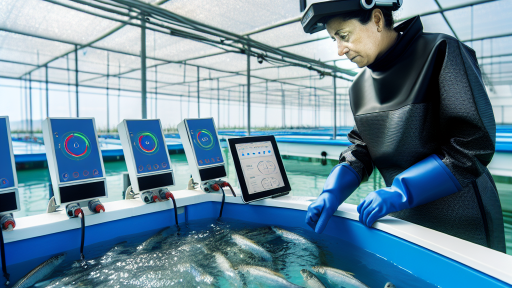Introduction to Sustainable Livestock Farming and Its Importance
Sustainable livestock farming focuses on practices that support environmental health.
It plays a crucial role in maintaining animal welfare and supports rural economies.
This practice reduces the negative impacts of livestock on natural resources.
Moreover, sustainable farming enhances food security for local communities.
By adopting sustainable practices, farmers can improve production efficiency.
Additionally, these methods lead to healthier livestock and healthier food for consumers.
Let’s explore the key elements that underline the importance of sustainable livestock farming.
Environmental Benefits
Sustainable livestock farming mitigates climate change effects.
It promotes biodiversity and protects ecosystems from degradation.
Furthermore, it utilizes resources more efficiently, reducing waste and emissions.
For instance, rotational grazing enhances soil health and fertility.
This practice prevents overgrazing, allowing land to recover and thrive.
Economic Viability
Sustainable farming can enhance profitability for farmers.
By reducing input costs, farmers can enjoy higher profit margins.
Moreover, consumers increasingly prefer products from sustainable sources.
Transform Your Agribusiness
Unlock your farm's potential with expert advice tailored to your needs. Get actionable steps that drive real results.
Get StartedThis shift creates new market opportunities for producers.
Investing in sustainable practices also attracts funding and support from various organizations.
Social Responsibility
Farmers practicing sustainability contribute positively to their communities.
They create jobs and support local economies through responsible practices.
Additionally, these farmers often provide healthier food options for consumers.
Furthermore, promoting animal welfare can enhance public trust and brand loyalty.
Cultivating community engagement fosters support for sustainable initiatives.
Overview of Breeding Strategies in Livestock Agriculture
Importance of Breeding Strategies
Breeding strategies play a crucial role in livestock farming.
They enhance production efficiency and animal health.
Furthermore, these strategies contribute to environmental sustainability.
Types of Breeding Strategies
Diverse breeding strategies exist within the livestock sector.
These include selective breeding, crossbreeding, and genetic engineering.
Each method has unique advantages and challenges.
Selective Breeding
Selective breeding focuses on choosing specific animals for reproduction.
This technique increases desirable traits such as growth rate and disease resistance.
However, it can lead to reduced genetic diversity over time.
Crossbreeding
Crossbreeding involves mating different breeds to improve offspring traits.
This strategy can enhance vigor and productivity in livestock.
For instance, crossing dairy and beef breeds can yield high-quality meat and milk.
Genetic Engineering
Genetic engineering introduces precise changes to an animal’s DNA.
This method allows for the expression of beneficial traits, such as disease resistance.
Nonetheless, ethical concerns and regulatory issues can arise.
Evaluating Breeding Programs
Effective breeding programs require careful evaluation and monitoring.
Farmers must assess performance metrics like growth, reproduction, and health.
Showcase Your Farming Business
Publish your professional farming services profile on our blog for a one-time fee of $200 and reach a dedicated audience of farmers and agribusiness owners.
Publish Your ProfileData analysis helps identify successful traits for future breeding efforts.
Challenges in Livestock Breeding
Several challenges face livestock breeding today.
Diseases, climate change, and market demands continuously evolve.
These factors affect breeding decisions and animal welfare.
Adapting to Changing Conditions
Adaptability is essential for successful breeding programs.
Farmers must consider environmental factors in their breeding choices.
For instance, selecting heat-tolerant breeds can enhance sustainability.
Balancing Productivity and Welfare
Maintaining a balance between productivity and animal welfare is vital.
Ethical breeding practices ensure the long-term success of livestock farming.
Farmers should actively promote humane treatment in breeding processes.
The Future of Livestock Breeding
The future of livestock breeding lies in innovation and responsibility.
Emerging technologies will continue to shape breeding strategies.
Moreover, sustainable practices must remain a priority in these developments.
Genetic Diversity and Its Role in Sustainable Breeding
Importance of Genetic Diversity
Genetic diversity is crucial for sustainable livestock farming.
It enhances the resilience of animal populations.
Higher diversity helps in adapting to changing environmental conditions.
It reduces the risks of disease outbreaks in livestock herds.
Furthermore, genetic diversity contributes to better overall herd performance.
Strategies to Maintain Genetic Diversity
Effective breeding strategies can promote genetic diversity.
- Crossbreeding different breeds helps maintain a healthy gene pool.
- Implementing rotational grazing encourages varied mating patterns.
- Utilizing artificial insemination can introduce new genetics into herds.
Benefits of Genetic Diversity
Maintaining genetic diversity offers several benefits.
- It enhances growth rates and reproductive performance.
- Genetic variance increases disease resistance.
- Biodiversity supports ecosystem stability, benefiting all species involved.
Challenges to Genetic Diversity
Several challenges threaten genetic diversity in livestock.
Intensive breeding practices often lead to inbreeding.
Commercial pressures may drive farmers toward fewer, high-yield breeds.
Additionally, climate change impacts the adaptability of livestock.
Future Directions
Looking ahead, sustainable breeding requires a proactive approach.
Farmers should prioritize genetic diversity in breeding selection.
Collaboration with geneticists can enhance breeding programs.
Moreover, educational efforts can raise awareness of genetic diversity’s importance.
Explore Further: Preventing Genetic Diseases in Livestock
Conservation of Local Breeds: Benefits and Challenges
Importance of Local Breeds
Local breeds play a vital role in sustainable livestock farming.
They are adapted to specific environmental conditions.
This adaptation leads to greater resilience against diseases.
Additionally, local breeds often require fewer resources for maintenance.
Benefits of Conserving Local Breeds
Conserving local breeds contributes to biodiversity.
They preserve genetic diversity within livestock populations.
This genetic variation enhances adaptability to changing climates.
Moreover, local breeds are often better suited for specific agricultural practices.
This suitability can lead to increased productivity and efficiency.
Challenges in Conserving Local Breeds
Despite their benefits, conserving local breeds presents challenges.
Many local breeds face threats from industrial agriculture.
Showcase Your Farming Business
Publish your professional farming services profile on our blog for a one-time fee of $200 and reach a dedicated audience of farmers and agribusiness owners.
Publish Your ProfileCommercial breeds often outcompete them due to mass production.
Additionally, lack of awareness about local breeds hinders conservation efforts.
Farmers may also prioritize short-term gains over long-term sustainability.
Strategies for Promotion and Conservation
Promoting local breeds requires education and awareness initiatives.
Farmers should be informed about the benefits and importance of local breeds.
Additionally, supporting local breed associations is crucial.
These organizations can provide resources and guidance for sustainable practices.
Furthermore, government policies should incentivize the conservation of local breeds.
Financial support can aid farmers in maintaining these valuable breeds.
Sustainable Practices in Agricultural Systems
Incorporating local breeds into farming systems fosters sustainability.
They enhance ecosystem health and promote agricultural diversity.
Ultimately, their conservation aligns with broader goals of sustainable livestock farming.
Learn More: Developing Genetic Improvement Plans for Livestock
Use of Technology in Breeding Programs
Precision Breeding
Precision breeding enhances the efficiency of livestock production.
This method focuses on making incremental genetic improvements in animals.
It utilizes advanced data analytics to select desirable traits.
Moreover, it minimizes the time required to achieve breeding goals.
Farmers can track genetic progress through sophisticated software.
- Enhanced disease resistance.
- Improved growth rates.
- Better feed efficiency.
These benefits significantly impact the sustainability of farming.
Overall, precision breeding supports lower resource consumption.
As a result, genetic improvements lead to healthier livestock.
Gene Editing
Gene editing revolutionizes livestock breeding strategies.
This technique enables precise modifications to an animal’s DNA.
CRISPR-Cas9 is one of the most popular gene-editing tools available.
This method holds the potential to eliminate genetic disorders.
Additionally, gene editing can enhance desirable traits quickly.
- Increased milk production in dairy cows.
- Higher disease resistance in pigs.
- Improved reproductive efficiency in sheep.
Ethical considerations surround the use of gene editing.
Public perception plays a key role in its acceptance.
Farmers must navigate regulatory landscapes when applying these techniques.
Nonetheless, the long-term benefits may outweigh these challenges.
Eventually, gene editing could reshape sustainable livestock farming.
Explore Further: Economic Benefits of Investing in Fish Farming
Breeding for Disease Resistance: Methods and Case Studies
Importance of Disease Resistance in Livestock
Disease resistance is critical in livestock farming.
It reduces reliance on antibiotics and other treatments.
This leads to healthier animals and safer food production.
Additionally, resilient livestock can thrive in varying conditions.
Breeding Methods for Disease Resistance
Several effective methods exist for breeding disease-resistant livestock.
Traditional selection focuses on the best performers in specific conditions.
- Farmers select animals that show fewer symptoms of diseases.
- Genomic selection uses genetic information to predict traits.
- Crossbreeding introduces diversity, enhancing resistance.
Traditional Breeding Practices
Farmers often rely on traditional methods for disease resistance.
This process involves selecting animals based on observable traits.
Showcase Your Farming Business
Publish your professional farming services profile on our blog for a one-time fee of $200 and reach a dedicated audience of farmers and agribusiness owners.
Publish Your ProfileFor instance, sheep with natural immunity to foot rot are preferred.
Modern Genetic Approaches
Modern techniques offer precise methods for breeding.
Genomic selection identifies specific genes related to disease resistance.
This strategy accelerates the breeding process significantly.
It also helps in developing targeted breeding programs.
Case Studies of Successful Breeding Programs
Case Study: The Use of Genomic Selection in Cattle
A successful program in the United States used genomic selection.
Farmers targeted cattle that showed resistance to BRD, or bovine respiratory disease.
The results showed a significant decrease in disease incidents.
This program improved overall herd health and profitability.
Case Study: Crossbreeding in Chickens
A poultry farm in Brazil implemented a crossbreeding program.
They aimed to develop chickens resistant to avian influenza.
The farm successfully produced a new breed with higher survival rates.
Enhanced biosecurity measures further supported these efforts.
Challenges and Considerations
Although beneficial, breeding for disease resistance faces challenges.
Genetic diversity must be maintained within livestock populations.
Moreover, environmental factors can influence the expression of traits.
Farmers must also invest in education to implement these strategies effectively.
Uncover the Details: Creating a Successful Breeding Program from Scratch

Integrating Animal Welfare into Breeding Decisions
Understanding the Importance of Animal Welfare
Animal welfare is crucial for sustainable livestock farming.
Healthy animals produce better quality products.
Moreover, welfare considerations improve farming practices overall.
Assessing Breeding Goals
Breeding goals should encompass animal well-being.
Farmers must balance productivity with welfare standards.
Consider selecting breeds known for good temperament.
Furthermore, look for traits that enhance health and longevity.
Implementing Welfare Indicators
Welfare indicators help assess animal conditions effectively.
Common indicators include behavior, health, and housing quality.
Regular assessments provide insights into animal needs.
Utilizing these indicators informs breeding decisions.
Engaging Stakeholders in Decision-Making
Stakeholder involvement enhances transparency in breeding decisions.
Engage veterinarians, consumers, and animal welfare groups.
Each group can offer valuable perspectives on welfare standards.
Fostering collaboration promotes ethical breeding practices.
Educating Farmers on Welfare Practices
Education equips farmers with knowledge to improve welfare.
Training programs should focus on best practices.
Workshops can address animal behavior and health management.
Additionally, farmers benefit from sharing experiences with each other.
Evaluating Breeding Outcomes
Continuous evaluation is vital for maintaining welfare standards.
Assess breeding outcomes against established welfare goals.
Modifying practices based on results ensures ongoing improvement.
Showcase Your Farming Business
Publish your professional farming services profile on our blog for a one-time fee of $200 and reach a dedicated audience of farmers and agribusiness owners.
Publish Your ProfileAdditionally, consider feedback from stakeholders to guide changes.
The Economic Impact of Sustainable Breeding Practices
Increasing Productivity and Profitability
Sustainable breeding practices enhance livestock productivity significantly.
Higher productivity leads to increased profitability for farmers.
This approach allows farmers to meet rising market demands efficiently.
Moreover, sustainable breeding improves the resilience of livestock to diseases.
Reducing Costs
Implementing sustainable breeding reduces feed costs effectively.
Animals raised through sustainable methods often require less medication.
This decreases overall veterinary expenses significantly.
Consequently, farmers enjoy a higher margin on their investments.
Enhancing Market Access
Consumers increasingly prefer sustainably raised livestock products.
This trend opens new market opportunities for farmers.
Farmers can command premium prices for organic and sustainable products.
Additionally, sustainable practices can lead to contract opportunities with retailers.
Gaining Competitive Advantage
Farmers who adopt sustainable breeding can differentiate themselves in the market.
This creates a competitive edge over conventional farming practices.
Furthermore, it supports a positive brand image and community goodwill.
As a result, loyal customers return to support sustainably focused businesses.
A Long-Term Investment
Sustainable breeding is a long-term investment in the agriculture sector.
By improving soil health and biodiversity, it ensures future productivity.
Farmers who invest in these practices will build a sustainable legacy.
This investment benefits not only the farmer but also the community at large.
Future Directions in Sustainable Livestock Breeding
Advancements in Genetic Technology
Genetic technology is transforming livestock breeding practices.
Innovative techniques enhance animal productivity significantly.
Tools such as CRISPR allow for precise genetic modifications.
Such advancements increase disease resistance among livestock.
Ultimately, these strategies contribute to reduced reliance on antibiotics.
Integrating Ecological Farming Practices
Ecological methods are vital in sustainable livestock breeding.
Holistic grazing techniques enhance soil health and biodiversity.
Incorporating diverse forage species improves animal nutrition.
This approach leads to healthier livestock and sustainable ecosystems.
Moreover, ecological methods reduce negative environmental impacts.
Collaboration with Local Communities
Engaging local communities benefits sustainable livestock farming initiatives.
Collaboration fosters knowledge sharing among farmers.
Moreover, it strengthens local food systems and economies.
Local breeds often possess traits suited to specific environments.
Promoting these breeds ensures genetic diversity in livestock populations.
Continuous Education and Training
Ongoing education is paramount for farmers in sustainable practices.
Workshops and training sessions offer vital information on new techniques.
Farmers can learn about animal welfare, genetics, and ecology.
Implementing learned strategies enhances overall farming efficiency.
Showcase Your Farming Business
Publish your professional farming services profile on our blog for a one-time fee of $200 and reach a dedicated audience of farmers and agribusiness owners.
Publish Your ProfileMoreover, informed farmers can better adapt to changing conditions.
Policy Support and Funding
Government policies play an essential role in supporting sustainable practices.
Incentives for adopting sustainable breeding strategies are critical.
Funding programs can assist farmers with research and development.
Additionally, policies encouraging local and organic products promote sustainability.
Working with policymakers leads to beneficial frameworks for farmers.
Additional Resources
Agriculture and Rural Communities – Fourth National Climate …
Synergistic power of genomic selection, assisted reproductive …




